This article was medically reviewed by Luba Lee, FNP-BC, MS. Luba Lee, FNP-BC is a Board-Certified Family Nurse Practitioner (FNP) and educator in Tennessee with over a decade of clinical experience. Luba has certifications in Pediatric Advanced Life Support (PALS), Emergency Medicine, Advanced Cardiac Life Support (ACLS), Team Building, and Critical Care Nursing. She received her Master of Science in Nursing (MSN) from the University of Tennessee in 2006.
There are 8 references cited in this article, which can be found at the bottom of the page.
This article has been viewed 307,138 times.
Medical professionals use finger splints to treat sprained, broken, or dislocated fingers. It's important to seek medical attention for a finger injury, but you may need to apply a temporary splint in some situations. Assess the injury to determine if it requires immediate medical attention. Then, apply a temporary splint and first aid until you can see someone. After that, follow your doctor’s instructions for how to care for the splint and your injured finger.
Steps
Applying a Temporary Splint and First Aid
-
1Assess the injury and stop using the finger immediately. It’s important to stop using the finger for anything after you injure it. No matter how you got the injury, stop what you’re doing and assess the injured finger. Seek immediate medical attention if your finger:[1]
- Feels numb or you cannot move it
- Hurts, especially in the bones over the joints
- Has red streaks extending from the injury
- Has been injured before
- Is cut or broken and the bone is visible
-
2Place the finger against a splint or clean popsicle stick. If you have a minor sprain, you can splint it until you can see a doctor. Buy a splint in the first aid section of a drug store or use a straight, hard object. Choose something that is about the same length or slightly longer than the finger. A clean tongue depressor or popsicle stick works well. Once you have a splint, press it against the underside of the injured finger and hold it there gently. Don't squeeze the finger or apply pressure to the injured area.[2]
- Make sure to position the splint so that it is under the injured joint.
Tip: Another option is to tape the finger to the one next to it, also known as buddy taping. However, buddy taping will not completely immobilize the finger. It will only keep it straight while the finger next to it is straight.[3]
Advertisement -
3Wrap medical tape above and below the point of injury. Next, secure the splint to the finger by wrapping medical tape around it 3 times at 2 separate points. Wrap medical tape around the finger at the base of the fingernail and above the knuckle next to the hand. Make sure that the tape is snug, but still loose enough to ensure good circulation.[4]
- If you don’t have medical tape, you can also use regular clear tape.
-
4Apply ice to the injured finger to reduce pain and swelling. Wrap an ice pack in a towel or paper towel and press it against the injured finger. Ice the finger for 10 to 20 minutes, and then remove it from the ice pack. Then, wait for the skin to return to its normal temperature before icing it again. This will take about 1 to 2 hours.[5]
- If you don’t have an ice pack, a bag of frozen corn or peas also works well. Just wrap it in a clean cloth or paper towel first.
-
5Take ibuprofen or acetaminophen for pain. If the finger hurts, take an over-the-counter pain reliever, such as ibuprofen or acetaminophen. This will help you to get some relief. Make sure to follow the manufacturer’s instructions for how much to take and how often to take it.[6]
- Keep in mind that the pain should start to subside after the first 24 to 48 hours. However, if the pain is worse or isn’t improving, call your doctor.
-
6Keep your hand elevated above the level of your heart. Holding your affected hand above the level of your heart will help to reduce swelling. Prop your hand up on a pillow while you’re seated or lying down, or hold it up near your shoulder while you’re standing.[7]
Seeking Medical Attention
-
1See a doctor for an injured finger as soon as possible. If you have a sprained or broken finger, call you doctor or visit an urgent care center for treatment. Your healthcare provider will assess the injured finger and apply an appropriate splint for the location and type of injury. They may also need to realign the finger before placing it in a splint, but they'll give you a local anesthetic to numb the finger first.[8]
- The sooner you get treatment for a sprained or broken finger, the better. Depending on the severity of the injury, it may take up to 3 to 4 months to heal. But delaying treatment can delay healing and lead to other complications, such as a skin infection.
-
2Get X-rays to determine what type of injury you have. Your doctor will likely order X-rays to see if the finger is broken, dislocated, or sprained. This can help them to determine what type of splint will work best and whether they need to realign the bones before applying a splint.[9]
-
3Let the healthcare professional apply a splint to your injured finger. After your doctor reviews the X-rays, they can determine what type of splint will work best and apply it. There are different types of splints and your doctor will choose the best option depending on the location and type of injury. Some common types include:[10]
- Mallet finger splint for correcting a finger that you cannot straighten[11]
- Aluminum U-shaped splint for a distal phalangeal fracture
- Dorsal extension block splint for a joint dislocation[12]
-
4Get a tetanus shot and antibiotics if the finger was cut. If you cut your finger, your doctor will likely recommend a tetanus shot to protect you against tetanus. They may also recommend a topical or oral antibiotic to prevent a skin infection.[13]
Tip: A tetanus shot might not be necessary if you’ve had a tetanus booster shot within the last 5 years. Make sure to tell your doctor when your last tetanus booster shot was.
-
5Discuss surgical options with your doctor if the injury is severe. If your finger is severely injured, it may not heal properly without surgery. Discuss surgical repair options with your doctor if they recommend surgery. However, keep in mind that this is uncommon. Most finger injuries heal well with a splint in about 4 to 8 weeks.[14]
Caring for the Splint
-
1Cover the splint with a plastic bag when you bathe. It’s important to keep the splint clean and dry. Cover your whole hand with a plastic bag whenever you take a shower or bath. Place a plastic bag over your hand and then secure it at your wrist with a rubber band. Use your other hand to wash yourself and angle your hand so that water won’t get into the bag.[15]
- Remove the plastic bag right after you finish your shower and pat your hand and the splint dry if needed.
-
2Wear the splint for as long as your doctor advises. It may take up to 8 weeks for your finger to heal depending on the severity of the injury. Keep the splint on during the day and at night until your doctor tells you it’s okay to stop wearing it. Not wearing the splint as instructed can lead to delayed healing or re-injury of the finger.[16]
-
3Check your finger daily to ensure that you have good circulation. If you notice that your finger is an unusual color or if it feels numb, tingly, or painful, the splint may be too tight. Remove the splint by pulling or cutting off the tape and contact your doctor as soon as possible.[17]
Tip: An easy way to check your circulation is by squeezing the end of your finger. Squeeze it gently for 3 seconds and then release it. Watch the color of the finger change from white to pink. If it doesn’t change right away, then the splint may be on too tight.
-
4See your doctor if the splint feels uncomfortable. Never try to trim a splint on your own. If the splint feels uncomfortable or if it has rough edges that are irritating you, call your doctor and make an appointment. They can trim or adjust the splint for you to make it more comfortable.[18]
Expert Q&A
Did you know you can get expert answers for this article?
Unlock expert answers by supporting wikiHow
-
QuestionCan I splint my thumb?
 Luba Lee, FNP-BC, MSLuba Lee, FNP-BC is a Board-Certified Family Nurse Practitioner (FNP) and educator in Tennessee with over a decade of clinical experience. Luba has certifications in Pediatric Advanced Life Support (PALS), Emergency Medicine, Advanced Cardiac Life Support (ACLS), Team Building, and Critical Care Nursing. She received her Master of Science in Nursing (MSN) from the University of Tennessee in 2006.
Luba Lee, FNP-BC, MSLuba Lee, FNP-BC is a Board-Certified Family Nurse Practitioner (FNP) and educator in Tennessee with over a decade of clinical experience. Luba has certifications in Pediatric Advanced Life Support (PALS), Emergency Medicine, Advanced Cardiac Life Support (ACLS), Team Building, and Critical Care Nursing. She received her Master of Science in Nursing (MSN) from the University of Tennessee in 2006.
Board-Certified Family Nurse Practitioner
-
QuestionI believe I jammed my middle finger. I bought a splint but it only covered to my knuckle. Should the splint go all the way to the base of my finger? I have it only in my palm below my middle finger.
 Luba Lee, FNP-BC, MSLuba Lee, FNP-BC is a Board-Certified Family Nurse Practitioner (FNP) and educator in Tennessee with over a decade of clinical experience. Luba has certifications in Pediatric Advanced Life Support (PALS), Emergency Medicine, Advanced Cardiac Life Support (ACLS), Team Building, and Critical Care Nursing. She received her Master of Science in Nursing (MSN) from the University of Tennessee in 2006.
Luba Lee, FNP-BC, MSLuba Lee, FNP-BC is a Board-Certified Family Nurse Practitioner (FNP) and educator in Tennessee with over a decade of clinical experience. Luba has certifications in Pediatric Advanced Life Support (PALS), Emergency Medicine, Advanced Cardiac Life Support (ACLS), Team Building, and Critical Care Nursing. She received her Master of Science in Nursing (MSN) from the University of Tennessee in 2006.
Board-Certified Family Nurse Practitioner
Warnings
- Do not attempt to treat a broken, sprained, or dislocated finger at home.⧼thumbs_response⧽
References
- ↑ https://www.mayoclinic.org/first-aid/first-aid-sprain/basics/art-20056622
- ↑ https://www.youtube.com/watch?v=HF3Zt4utdUg&feature=youtu.be&t=90
- ↑ https://www.nhs.uk/conditions/broken-finger/
- ↑ https://www.youtube.com/watch?v=HF3Zt4utdUg&feature=youtu.be&t=111
- ↑ https://medlineplus.gov/ency/patientinstructions/000538.htm
- ↑ https://medlineplus.gov/ency/patientinstructions/000538.htm
- ↑ https://www.nhs.uk/conditions/broken-finger/
- ↑ https://www.aafp.org/afp/2006/0301/p810.html
- ↑ https://www.aafp.org/afp/2006/0301/p810.html
- ↑ https://www.nhs.uk/conditions/broken-finger/
- ↑ https://medlineplus.gov/ency/patientinstructions/000538.htm
- ↑ https://www.aafp.org/afp/2009/0901/p491.html
- ↑ https://www.nhs.uk/conditions/broken-finger/
- ↑ https://www.nhs.uk/conditions/broken-finger/
- ↑ https://medlineplus.gov/ency/patientinstructions/000538.htm
- ↑ https://medlineplus.gov/ency/patientinstructions/000538.htm
- ↑ https://medlineplus.gov/ency/patientinstructions/000538.htm
- ↑ https://www.assh.org/handcare/procedures-and-treatment/cast-splint-care
About This Article
If you have a bruised or broken finger, you'll need to attach a splint to it to protect it from further damage. If your bone is visible through your skin, your finger is deformed, or you feel a numb or tingling sensation, seek medical attention so your doctor can splint your finger and prescribe any medication. However, if your finger isn’t deformed, purchase a commercial splint from a drug store or online. Alternatively, make one at home with 2 straight, firm objects like big paper clips, popsicle sticks, or pieces of hard cardboard. If the objects are longer than your finger, cut them down to the right size. Then, put the splints on either side of your finger and secure them with medical tape. For more tips, including how to attach a commercial splint to your finger, read on!

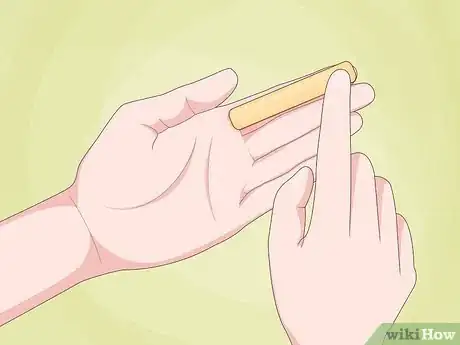



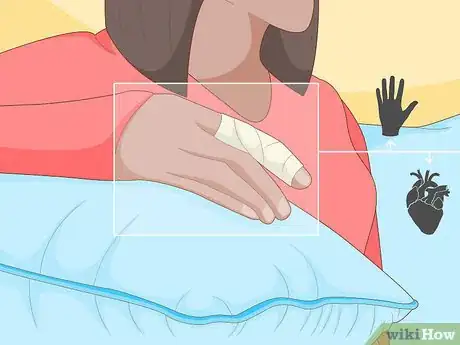

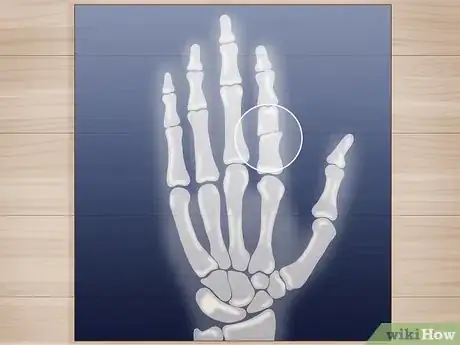
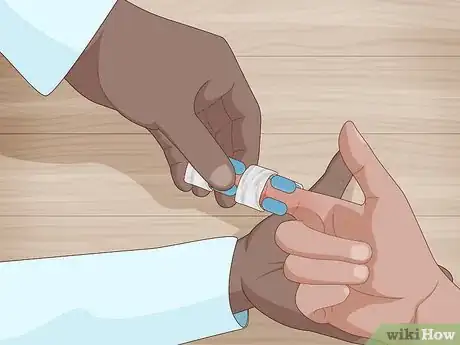
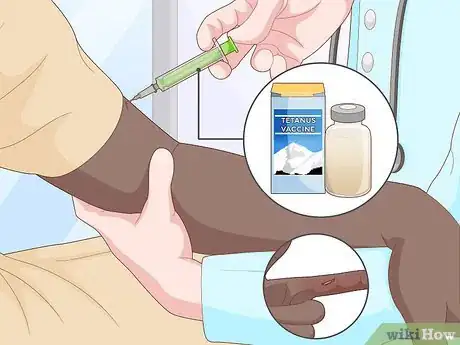
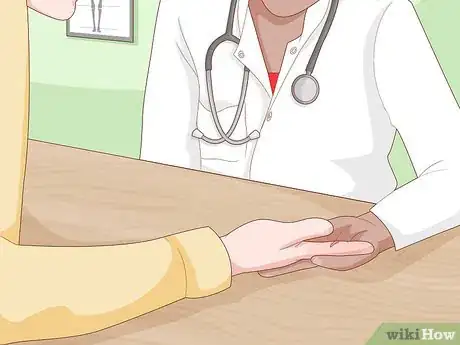

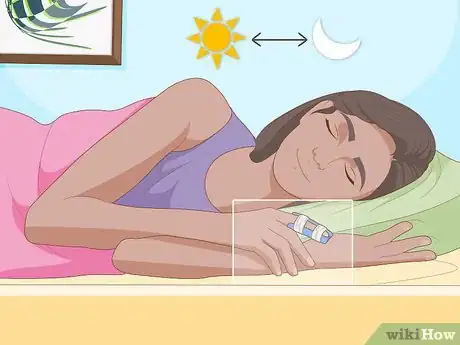

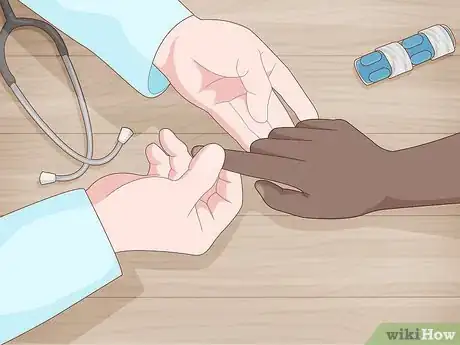
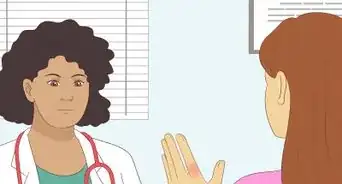
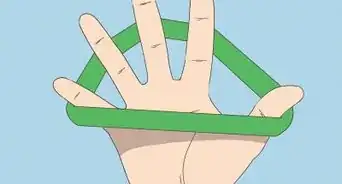

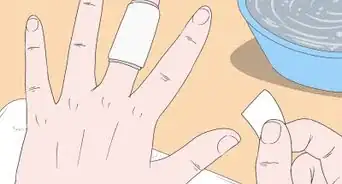
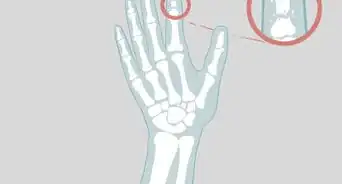





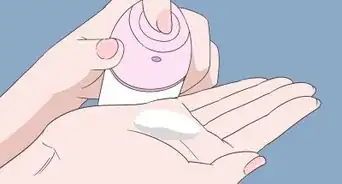










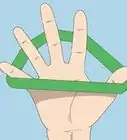
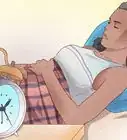
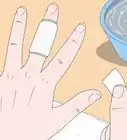



































Medical Disclaimer
The content of this article is not intended to be a substitute for professional medical advice, examination, diagnosis, or treatment. You should always contact your doctor or other qualified healthcare professional before starting, changing, or stopping any kind of health treatment.
Read More...